Source: Chain Tea House
Livepeer is a decentralized live video streaming protocol developed based on the Ethereum blockchain, allowing users to transcode videos in real time upon request.

Based on a scalable Platform as a Service (PaaS), Livepeer is suitable for startups and organizations that want to add live or on-demand video to their products. At its core is an Ethereum-based video transcoding protocol (reformatting videos to accommodate a variety of bandwidths and devices), which is designed to provide a cost-effective, secure and reliable infrastructure that can meet today's high demand for video streaming.
Unlike other traditional video streaming service providers such as YouTube, Livepeer does not store, manage or transmit videos. It utilizes unused CPU resources, allowing users to broadcast live videos or integrate video streaming into their applications and websites, greatly simplifying the process of video publishers distributing videos and providing a more cost-effective solution.
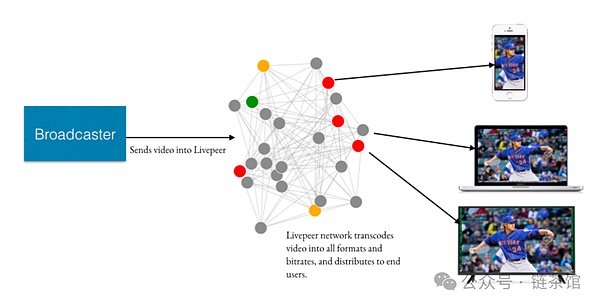
In addition, the network uses a modified version of the Delegated Proof of Stake (DPoS) consensus mechanism, in which new blocks are verified by staking tokens instead of mining. Its native token is LPT, a work token based on the ERC-20 standard of the Ethereum blockchain, which users can use to ensure the security of their work on the network.
I. How it works
The core of Livepeer's operation is the Ethereum-based video transcoding protocol, which distributes video transcoding tasks through a decentralized network. This protocol aims to provide a cost-effective, secure and reliable infrastructure to cope with today's high demand for video streaming.

Here is a detailed introduction to its working principle:
Video transcoding process
1. Video stream transmission
Video content creators or broadcasters send original video streams to the Livepeer network. These broadcasters may be individuals, companies, or any entities that need video transcoding services.
2.Receiving and transcoding task allocation
In the Livepeer network, nodes called "orchestrators" receive these video streams. Orchestrators are nodes that contribute their own computing resources (CPU/GPU) and network bandwidth to participate in network activities.
Orchestrators perform preliminary processing on the received video streams and are responsible for allocating transcoding tasks to specific transcoders. These transcoders are usually GPUs or other dedicated hardware with video encoding capabilities.
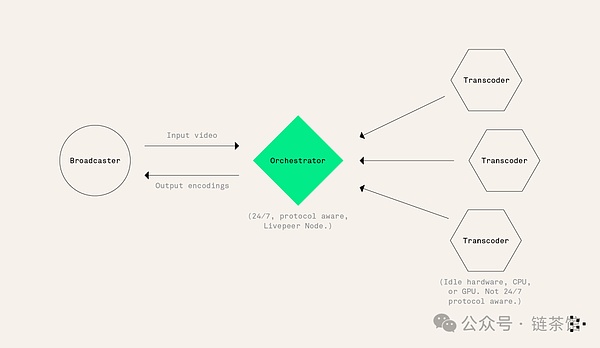
3. Transcoding execution:
The transcoder receives the video stream from the orchestrator and converts the video from the original format to a format suitable for different screen sizes and different network speeds as required. This includes resolution adjustment, bit rate adjustment, encoding format change, etc.
During the transcoding process, the video file is re-encoded to ensure its compatibility and optimal playback effect on the target device
4. Transcoded video return:
Once the video transcoding is completed, the transcoder sends the transcoded video stream back to the orchestrator. The orchestrator is responsible for reviewing these video streams to ensure quality and returning the final video stream to the video broadcaster or directly publishing it to the designated platform.
5. Fees and Incentives:
In the Livepeer network, broadcasters need to pay Ether (ETH) as a fee for transcoding services. These fees are paid to orchestrators and transcoders participating in transcoding as compensation for their provision of computing resources and bandwidth.
The number of LPT tokens held by orchestrators and transcoders also determines how many transcoding tasks they can receive in the network, that is, the amount of LPT tokens staked is proportional to the transcoding tasks obtained.
2. Consensus Mechanism
Livepeer uses a special consensus mechanism that combines the security of Ethereum with a layer designed specifically for its network operations to handle specific tasks and reward distribution.
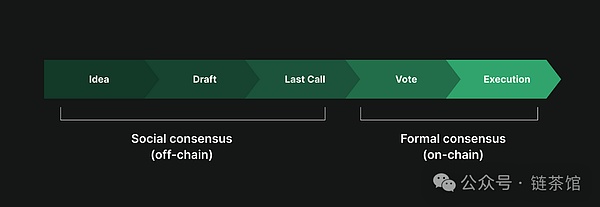
This consensus mechanism is mainly divided into two layers. The following is a detailed introduction to the two consensus mechanisms:
1. Ethereum blockchain layer
The first-layer consensus mechanism of the Livepeer network relies on the Ethereum blockchain. At this layer, all transactions and smart contract interactions are recorded and verified. This includes LPT token transactions, pledge and unstake events, and payment and fee processing.
Relying on the security of the Ethereum blockchain, this layer ensures that all financial operations of the Livepeer network are transparent and immutable, while leveraging Ethereum's wide acceptance and stability to provide basic security.
2. Delegated Proof of Stake (DPoS) layer
The second-layer consensus mechanism is based on delegated proof of stake (DPoS) and specifically handles verification and reward distribution related to video transcoding tasks. In the DPoS model, LPT token holders can choose to become "Orchestrators" or delegate their tokens to other Orchestrators.
As the network's verification nodes, Orchestrators are not only responsible for video transcoding, but also need to verify the transcoding work of other nodes. This layer of consensus mechanism ensures that the transcoding task is completed correctly and that the transcoding results meet the expected quality standards.
Orchestrators verify the processing results of the video stream and participate in the generation and distribution of new LPT tokens. This mechanism promotes the normal operation and development of the network and encourages participants to maintain honest and efficient behavior.
3. Actual operation of the consensus mechanism
In the Livepeer network, when an Orchestrator completes a transcoding task, it can verify the correctness of the work by itself or delegate it to other Orchestrators for cross-verification. Since the cost of verifying all the work can be very high, Livepeer uses random checks to verify the accuracy of the work, which can significantly reduce the cost of operation while maintaining the security and reliability of the network.
LPT tokens play a key role in this process. As a "security deposit", if the Orchestrator misbehaves (such as providing incorrect transcoding results), its staked LPT may be fined, which increases the risk cost of malicious behavior.
Through this two-layer consensus mechanism, Livepeer is able to ensure the security and reliability of the network while maintaining efficiency and cost-effectiveness. This structure not only takes advantage of the power of the Ethereum blockchain, but also optimizes operations specific to video transcoding services through the unique design of the DPoS layer.
Three, LPT Tokens
LPT tokens are the native tokens in the Livepeer network, based on the ERC-20 standard of the Ethereum blockchain.
1. Purpose and Function
LPT tokens are used to incentivize network participants, including video transcoders (called "orchestrators" in the network) and token holders ("delegators"). Orchestrators are responsible for handling video transcoding tasks, while delegators support specific orchestrators by staking LPT tokens to help maintain network security.
Users holding LPT tokens can participate in the governance decisions of the Livepeer network and vote on the future development direction of the network and protocol updates.
Voting and Governance
Network Security and Incentives
2. Economic Model

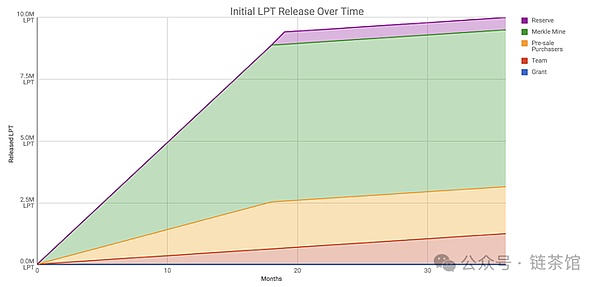
The total number of LPT tokens issued is 22,858,012, of which about 12.35% are held by the founding team and unlocked after three years. About 19% of the tokens were sold in the presale, while 63.437% were allocated for public trading. 0.213% were issued to several early advisors and contributors who helped Livepeer get started. 5% is used to maintain and develop the Livepeer platform to ensure the longevity of the Livepeer project.
LPT is an inflationary token with no set maximum supply cap. Through inflation, new LPT tokens are created and distributed to participants who actively participate in the operation of the network, such as Orchestrators who transcode video streams and Delegators who support them. This reward mechanism encourages more users to join and support the network, rewards active participants of the network, and provides incentives for new participants over time, while also increasing its decentralization and security.
The inflation rate of LPT is not fixed, but dynamically adjusted based on the staking rate of the entire network. The staking rate refers to what proportion of all LPT in circulation is staked in the network to support the operation of Orchestrators.
a. Token Distribution
b. Inflation Mechanism
3. Token Acquisition
Network Participation Rewards
The main way to obtain LPT tokens is by participating in the video processing work of the Livepeer network, especially as an Orchestrator or Transcoder. These roles participate in video transcoding tasks and provide the necessary computing resources and bandwidth to the network in exchange for LPT tokens as rewards.
Staking and Token Rewards
Users can participate in network maintenance by staking LPT tokens to an Orchestrator, a method called Delegating. Delegators stake their tokens to support a specific Orchestrator and receive a portion of the transcoding task revenue in proportion to the amount of stake they have invested.
Initial Token Distribution
In the early stages of the Livepeer network launch, the initial distribution of tokens is carried out through public sales, private placements, or initial coin offerings (ICOs). This provides an entry opportunity for early investors.
Community and Developer Incentives
The Livepeer community may reward community members and developers with LPT tokens through various incentives, such as bounty tasks, development grants, or creative competitions. These activities are designed to promote the technical development of the network and community participation.
Fourth, Livepeer Ecosystem
1. Delegators
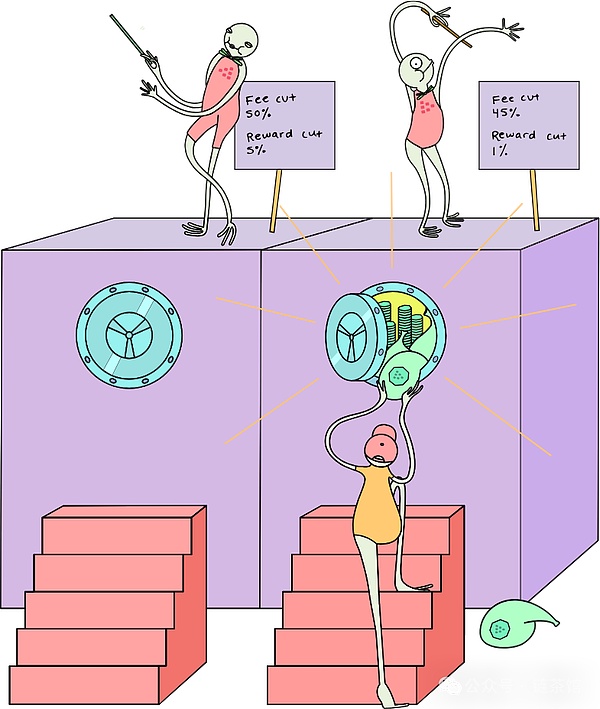
Delegators in the Livepeer ecosystem are individuals or entities who invest their Livepeer tokens (LPT) into the network to participate in the network consensus and receive rewards. They delegate their LPT to node operators who run the Livepeer software and perform transcoding work on the network. In return for delegation, the delegator can receive part of the node operator's rewards.
2. Orchestrators

Orchestrators in the Livepeer ecosystem are node operators who provide transcoding services to the network. They run the Livepeer software for video transcoding and distribute video clips on the network. Orchestrators compete with each other to perform transcoding work and earn service fees. They also participate in network consensus by holding their own Livepeer tokens (LPT) and can receive additional rewards when they are selected to verify transactions and create new blocks on the Livepeer blockchain.
3. Node Operators
Node operators are responsible for processing video sources and converting them into various formats to suit various devices and network configurations. Node administrators are the foundation of the Livepeer network. For participating in the network, they receive benefits in the form of LivePeer's native token LPT.
4. Transcoder Operators
These are also the node operators who are chosen to process videos and transcode them into various formats. In addition to the benefits of participating in the network, they can also receive payments for transcoding services.
5. Video Producers
Individuals or businesses that create video content and provide it to the Livepeer platform for delivery and processing are called video producers. In order to guarantee that their content is delivered with high quality and is able to reach a wider audience, they can decide to pay for transcoding services.
6. Users
People who watch video content distributed through the Livepeer network are called users. Without the need for specialized hardware or software, they can access video material and enjoy high-quality video streaming through a range of gadgets and networks.
7. Video Miners

Video miners in the Livepeer ecosystem are individuals who provide computing resources to the network to process and transcode video streams. By participating as video miners, they help ensure the scalability and reliability of the network, and in return, they receive LPT as a reward for their contribution. The number of LPTs received by video miners is proportional to the processing power and bandwidth they provide to the network.
8. Token Holders
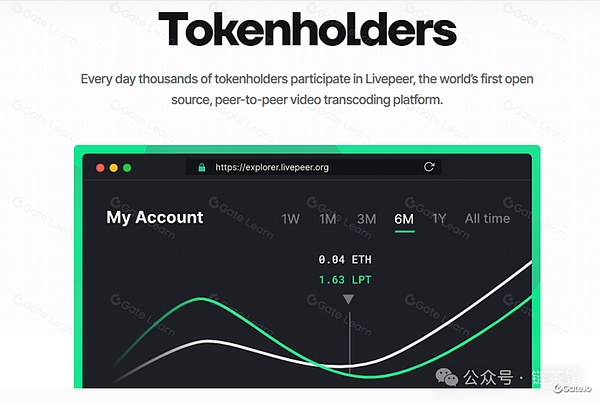
Token holders have the ability to participate in the governance of the network by voting on protocol upgrades and changes, and they can also receive a portion of the network's transaction fees as a reward. All transactions and interactions within the Livepeer ecosystem are recorded on the Ethereum blockchain, making them public and transparent. This ensures that everyone in the ecosystem can rely on the network and the services it provides
V. Livepeer Team/Cooperation/Financing/Investment
1. Team
Livepeer was launched in March 2017 by Doug Petkanics and Eric Tang. Livepeer is an open source protocol on GitHub, and developers are free to contribute to the core code. On the other hand, Livepeer Inc., co-founded by Petkanics and Tang, is the legal entity behind the project. Petkanics serves as CEO and brings experience in engineering and entrepreneurship, while CTO Tang has a deep technical background. The team consists of individuals with different skills such as technology, business development, and blockchain, and is committed to building a decentralized solution for video streaming.
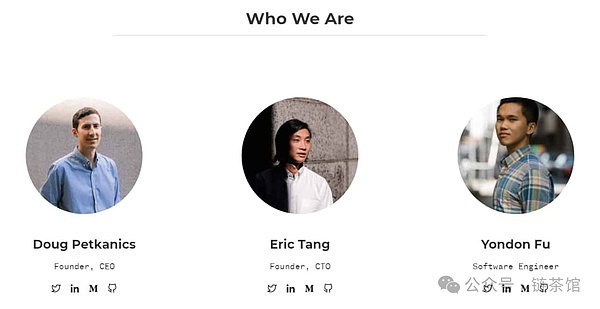
2. Partners
Livepeer has partnered with several companies and organizations to help drive adoption and use of its technology. These include:
ETHDenver: Livepeer partnered with ETHDenver to provide video infrastructure for the world's largest Ethereum hackathon.
DLive: DLive is a decentralized streaming platform that has partnered with Livepeer to provide decentralized and more scalable video infrastructure for its users.
Hashed: Hashed is a cryptocurrency investment firm that has invested in and partnered with Livepeer to help drive adoption of decentralized video infrastructure.
Parity Technologies: Livepeer has partnered with Parity Technologies to provide secure and scalable infrastructure for decentralized video streaming.
Band Protocol: Band Protocol is a decentralized oracle platform that has partnered with Livepeer to provide secure and decentralized data for video streaming applications.
3. Financing Status
Livepeer has raised a total of $48 million in funding, spread across four rounds of financing.
The most recent round is the B-II Series on January 5, 2022, which raised $20 million.
Investors in the financing include Alan Howard, Digital Currency Group, Northzone, Tiger Global Management, and Warburg Serres Investments.
In addition to public financing rounds, Livepeer may also have conducted other private or seed rounds of financing.
4. Acquisitions and Investments:
Livepeer acquired MistServer, an acquisition completed on November 8, 2021. MistServer is a streaming server solution.
Livepeer made a seed round investment in Web3 Working Group, which was completed on December 1, 2022, indicating that Livepeer is not only developing itself, but also investing in and supporting other technologies and projects in the ecosystem.
Six, Project Advantages

High-quality video: Livepeer uses blockchain technology to create a decentralized node network that performs video transcoding, resulting in high-quality video streams.
Community-driven development: Livepeer is an open source project, which means that its development is driven by a community of developers and users. This will lead to a more user-friendly and innovative platform.
Token incentives: Livepeer uses its own token LPT to incentivize participants to contribute to the network. For example, transcoders are incentivized to provide high-quality video streams by receiving rewards in the form of LPT tokens.
Privacy: Livepeer allows users to stream video content without revealing their identity because it runs on a decentralized network. This enhances privacy compared to centralized video streaming platforms, which may collect personal information and use it for advertising or other purposes.
Scalability: Livepeer is designed to scale as the network grows, which means it can handle more and more users and video streams without degrading performance.
Reduced latency: Livepeer's decentralized node network helps reduce latency in video streaming, resulting in a smoother and more responsive video playback experience.
VII. Project Disadvantages
Competition from centralized platforms: Livepeer faces competition from centralized video streaming platforms such as YouTube, Twitch, and Facebook. These platforms have significant advantages in resources and market share, which may make it difficult for Liverpeer to gain widespread adoption.
Regulatory risks: The regulatory environment for decentralized platforms is uncertain, and governments may introduce regulations that negatively affect the use and adoption of Livepeer.
Security Risks: As with any decentralized platform, there is a risk of hacking or other malicious activity. The decentralized nature of Livepeer makes it more vulnerable to such attacks, and there is a risk that user data and funds could be lost as a result.
Technical Complexity: The technical complexity of the Livepeer platform may make it difficult for non-technical users to understand and use the platform effectively. This may limit the adoption of Livepeer, especially among individuals who are not familiar with blockchain technology.
Limited Use Cases: Currently, the primary use case for Livepeer is decentralized video streaming, but it is unclear to what extent the platform will be used for this purpose. If the platform does not gain widespread adoption, it may struggle to realize its full potential and provide users with a return on investment.
Dependence on Ethereum: Because Livepeer runs on the Ethereum network, it relies on the stability and security of the Ethereum blockchain. If there are any issues with Ethereum, it could have a negative impact on Livepeer and its users.
Limited decentralization: While Livepeer aims to be a decentralized platform, it could become centralized over time if a small number of nodes end up controlling a majority of the network's computing power. This could harm the platform's decentralization and increase the risk of malicious activity.
Eighth, Future Development Forecast
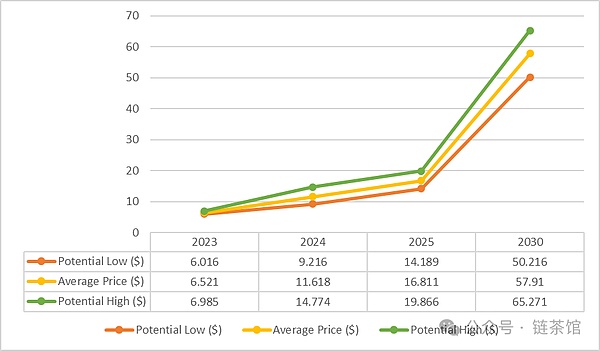
By the end of 2024, the price of LPT could reach a high of $14.774 while attracting more blockchain investors.
2025 LPT Price Prediction: The live video streaming market is developing rapidly. The Livepeer team hopes to take advantage of this trend and promote decentralization throughout the system. With the arrival of major updates and interesting new features, the price of LPT could reach $19.866 by 2025. Furthermore, if the token does not experience any major volatility, the average transaction cost could be $16.811. However, if the bears outweigh the longs, the price could bottom out at $14.189.
Livepeer Price Prediction 2026: According to our analysts, the LPT token price prediction 2026 could be between $18.25 and $25.66, and the average price of Livepeer could be around $21.87.
LPT Price Prediction 2027: According to our analysts, the Livepeer price 2027 could be between $23.94 and $31.10, and the average price of LPT could be around $27.31.
Livepeer Price Prediction 2028: According to our analysts, the LPT cryptocurrency prediction for 2028 might range between $35.26 and $47.86, and the average Livepeer token price might be around $41.61.
LPT Token Price Prediction 2029: According to our analysts, the Livepeer prediction for 2029 might range between $42.16 and $55.18, and the average LPT token price might be around $48.01.
Livepeer Price Prediction 2030: According to our analysts, the LPT prediction for 2030 might range between $50.21 and $65.27, and the average Livepeer price might be around $57.91.
IX. Project Summary
The Livepeer project is an innovative practice that combines video streaming and blockchain technology. It uses the decentralization and incentive mechanism of blockchain to try to change the way the traditional video streaming industry operates, reduce costs, and improve quality and privacy protection. Despite the competition, technology, and regulatory challenges, as blockchain technology continues to mature and the market demand for decentralized services grows, Livepeer has the opportunity to become a disruptor in the video streaming industry. In the future, Livepeer needs to continue to innovate and broaden use cases while ensuring the stability and security of the network to realize its vision in the field of decentralized video services.
 Anais
Anais



















